Expo
- 31 units available
- Studio • 1 bed • 2 bed • 3 bed
- Amenities
In unit laundry, Golf room, Patio / balcony, Granite counters, Hardwood floors, Dishwasher + more

Thinking of packing your bags and embarking on a new adventure? Minneapolis might be the perfect fit! This dynamic city offers a thriving job market, a diverse arts scene, and beautiful natural spaces. Before you make the leap, here's what you need to know about living in Minneapolis.
Negative wind chills and the monolithic Mall of America are some of the first things that come to mind when thinking of Minneapolis. But the city is also known for its booming tech scene, fabulous food, and culture that some say is second to only New York City.
There is also endless beauty and recreation in the local parks system, in addition to a pretty reasonable cost of living. It's easy to see why moving to Minneapolis is a popular choice for students, young professionals, and families
Minneapolis' population is over 430,000 people, and it's the most populous city in Minnesota. It's also grown over 12% in the last decade with no signs of slowing down.
At over 57.49 square-miles, Minneapolis is home to over 22 lakes and a thriving outdoor culture. Maybe it’s because they know the winter weather is coming, but locals love spending time biking and boating.
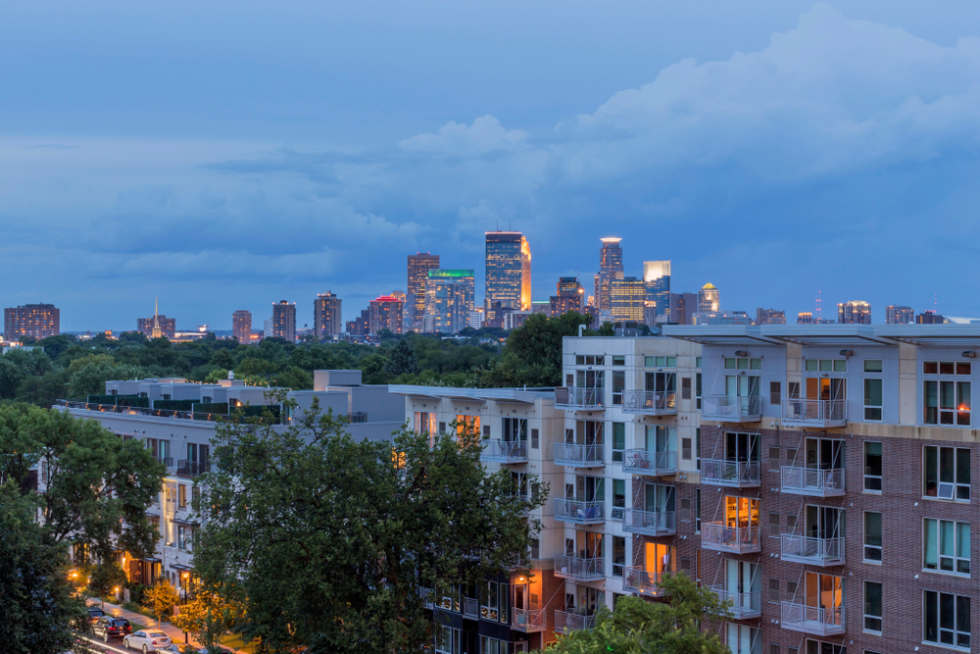
Living in the Twin Cities is pretty affordable. According to our database, the cost of living in Minneapolis in the city is only 7% higher than the national average. Median rents around Minneapolis are $1,262 for a one-bedroom apartment and $1,634 for a two-bedroom. That's above the national average, but less expensive than comparable urban areas.
You want to make sure you have the salary to enjoy Minneapolis’ nightlife and culture scene. If you're not sure what your salary should be to comfortably live in Minneapolis, you should consider following the 30% rule. The rule stipulates you should only spend 30% or less of your gross income on rent. If you're paying $1,262 for a one-bedroom, you should earn just over $50,000 a year before taxes. Of course, sharing an apartment with a few roommates will cut costs.
Locals don't love the taxes in Minnesota. The graduated income tax rate ranges from 5.35% to 9.85% and can impact your budget.
There's also a minimum sales rate tax of 8.03% for the state, county, and city tax rates. Despite the high taxes, the city has no sales tax on apparel and accessories. It makes a trip to the Mall of America easier on the wallet.
Renters from across the region move to Minneapolis. St. Cloud, Duluth, and Chicago residents are the top movers to this area. For more information, read our Renter Migration Report.

Minneapolis took an economic hit during the pandemic. However, the job market is coming around. Some major industries include health care and social assistance, government, manufacturing, retail trade, and hospitality.
Target's headquarters are located in Minneapolis and they’re a major employer. However, the pandemic has impacted jobs in retail and hospitality more than others.
The tech industry is rapidly growing around Minneapolis with new job opportunities. Minneapolis is home to accelerators and startups that support the entrepreneurial fabric of the city.
Minneapolis and St. Paul are known as the Twin Cities, but you have to unpack their history to understand why.
From the 1800s to the 1920s, Minneapolis was the flour milling capital of the world. Companies quickly moved in to get in on the booming industry. They brought wealth along with them.
The Twin Cities earned their nickname when an area called St. Anthony started growing. Locals went across the Mississippi River and established Minneapolis. The two cities operated independently for twenty years before becoming the single city of Minneapolis in 1872.
St. Paul had already been founded as the state capitol. It was a full day's carriage ride away from Minneapolis. The two areas were eventually dubbed the "Twin Cities."
Today, St. Paul is considered the more affordable of the twin cities. There's still art and culture in St. Paul, too. The city is home to the beaux arts Cathedral of St. Paul.
St. Paul is also smaller than its twin city, with a population of 300,000. The city has been deemed as one of the "most romantic" in the country. Couples take leisurely paddleboat rides along the Mississippi, ice skate, and take in the art scene.
Minneapolis also has another nickname, the "Mini Apple." Like New York City, Minneapolis is a highly literate city and has a thriving dining and theater scene. "Minneapolis" and "Mini Apple" are also similar and play off one another.
Even though there's over 520 stores at the Mall of America, there's more to do than just shopping. The mall spans 5.6 million square feet. It’s among the largest shopping and entertainment complexes on the continent.
The Mall of America doubles as an indoor theme park, SEA LIFE Minnesota Aquarium, and FlyOver America. It’s also an ideal place to escape the winter weather.
Although it's more of a tourist attraction than a local hot spot, it's still worth checking out at least once!
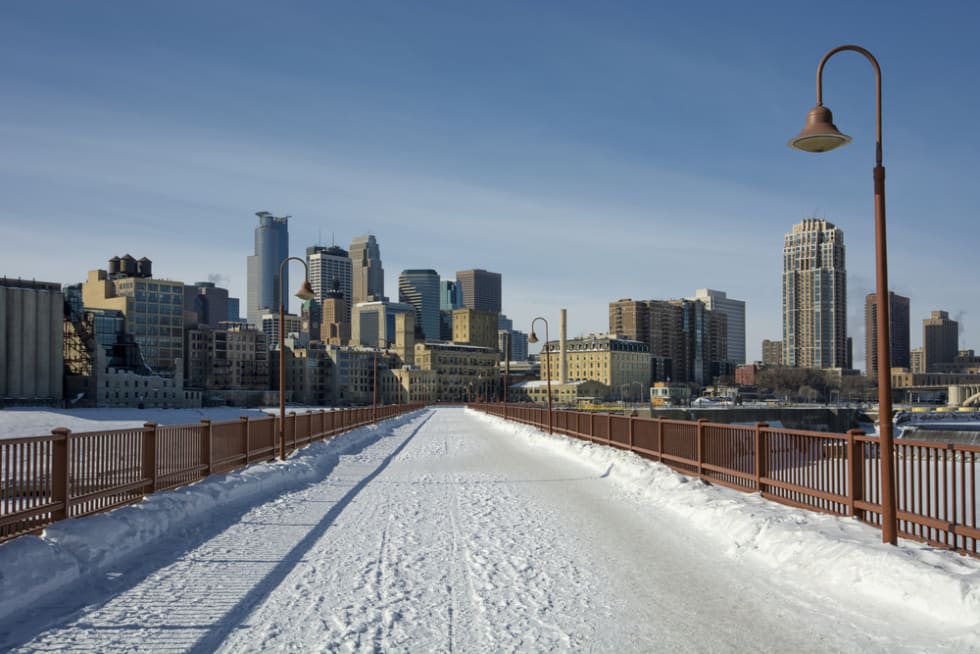
Locals aren't kidding around about how bitter the winters are in Minneapolis. Expect negative temperatures in January that keep dropping during blizzards. Minneapolis averages 52 inches of snow per year and only 198 sunny days.
Minneapolis is even colder than notoriously frigid places like Iceland. But locals came up with an innovative way to stay warm.
The Minneapolis Skyway System features interlinked closed pedestrian footbridges connecting buildings. It covers 80 city blocks and 9.5 miles. If you’re worried about the weather, look for a job that connects to the Skyway System.
There’s an upside to the winter weather in Minneapolis. Ice fishing is a unique pastime during the winter months when locals gather at Lake Harriet to cast their line.
You're also not far from Hyland Hills Ski Area and Como Park Ski Center to hit the slopes. Ice skating is also a popular winter favorite in Minneapolis.
The gorgeous lakes in the metro area may offset those brutal Minneapolis winters. Boating and spending the day on the water are also popular pastimes.
It's easy to see why they call Minnesota “10,000 Lakes” without leaving the city limits. Beyond the lakes, there are also five national parks and 76 state parks to choose from.

The City of Minneapolis has over 83 residential neighborhoods with something for everyone. Whether you're a family settling down, starting your career, or want to be near the action, check out some of the best neighborhoods in Minneapolis below to find the right one for you.
Downtown East is home to the Mill District and historic Stone Arch Bridge. Locals enjoy views of St. Anthony Falls and space to lounge at Mill Ruins Park. The neighborhood is also home to the famed Guthrie Theater, restaurants, and cozy cafes.
Ericsson is the home to Lake Hiawatha and a surrounding namesake park. Golfing and outdoor recreation are popular pastimes in the neighborhood.
You'll also find Lake Nokomis south of the community. That’ll let you spend even more summer days on the water.
North Loop is also known as the Warehouse District. It’s home to startups and trendy nightlife options.
A local farmer's market sells locally sourced goods, candy, and wares. The converted warehouses are home to design shops. You can also see the Minnesota Twins play at the local Target Field.
University of Minnesota students and trendsetters settle in Dinkytown. Secondhand shops, used bookstores and dive bars are common in the neighborhood. It's also the place where indie bands perform in quirky venues.
Literary lovers will feel right at home in Longfellow. The neighborhood was named after Henry Wadsworth Longfellow and offers a historic vibe. Views are spectacular along the Mississippi River Gorge and feature biking and hiking trails.
Art lovers settle in the Northeast Minneapolis Arts District. The neighborhood is teeming with art studios, performance spaces, and galleries. Beyond the arts scene, craft breweries and trendy shoes line the street.
Prospect Park is also a popular option with college students and university staff from the University of Minnesota and University Avenue. The winding neighborhood features a mix of landmarks and urban amenities.
Minneapolis neighborhoods feature a mix of luxury high-rises, smaller apartment complexes, and condos for rent. More walkable cities with amenities or spectacular views come with a higher price tag.
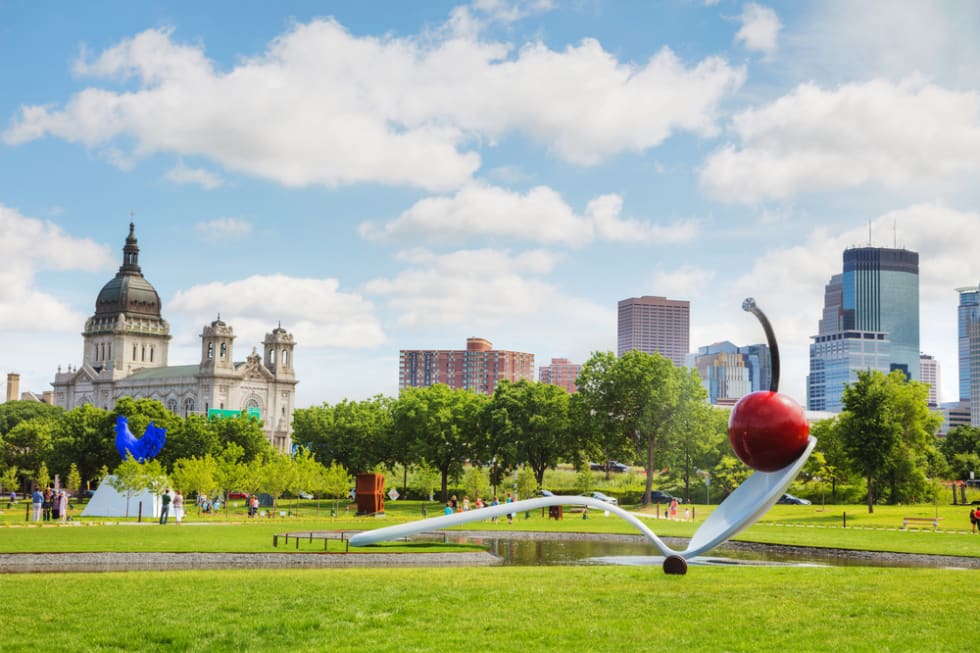
The Minneapolis park system ranks among the best in the nation. The system is also listed in the top ten of Trust For Public Land's 2018 ParkScore Index.
The Chain of Lakes in Uptown offers lakes, beaches, sailing school, and volleyball. Mill Ruins Park and Boom Island Park are also among the best parks in the city for views and enjoying summer weather.
You don't have to leave Minneapolis to see a towering waterfall. Minnehaha Park is within the city limits at the intersection of Hiawatha and Minnehaha Parkway.
Its namesake waterfall tumbles from 53 feet high. St. Anthony Falls and Shadow Falls are also nearby for more opportunities for exploring.
Despite it being so cold outside, Minneapolis is a walkable city. The official walk score is 70 and strolls along the banks of the Mississippi River are popular. Minneapolis' bike score is 84 and offers over 100 miles of bike lanes and kiosks for bike-sharing.
You can also get around by public transportation. The Minneapolis METRO runs a commuter rail, buses, and light rail that gets locals around town.
The transit score is 57. That opens up to the city for exploring the arts, nightlife, and outdoor recreation.
It’s possible to live in Minneapolis without a car, but most locals have one anyway. It's challenging to get around the city during winters when being outdoors is brutal for biking and walking.
Look for apartments with covered parking or you might get snowed in. Salt and snow on your car can also cause rust and wear and tear.
Music is celebrated in Minneapolis with year-round live music, concerts, and festivals. The city is considered a top 10 city for live music and hosts some of the biggest acts trending the charts. Minneapolis was also the birthplace of Prince, and every local seems to have a story about him.
Minneapolis has been dubbed "the Silicon Valley of Food" with over a dozen James Beard finalists and winners.
Spoon and Stable features Midwest seasonal fare and a full menu at the bar. For Italian, Monello offers seafood, Italian cuisine, and craft cocktails.
Minneapolis is also known for the Juicy Lucy cheeseburger. Cheese is cooked right inside the meat instead of on the top. Locals dine on Juicy Lucy's at the 5-8 Club that was formerly a 1920s speakeasy. Foodie rivals swear Matt's Bar was the first to introduce Juicy Lucy.
Seattle may have introduced Starbucks to the world, but Minnesota brought ethically sourced coffee to the masses. Minneapolis' Peace Coffee was the country's first importer of fair-trade coffee.
Coffee is serious business around Minneapolis. Cafe Imports, the independent importer and developer of green coffees, is also headquartered in the city.
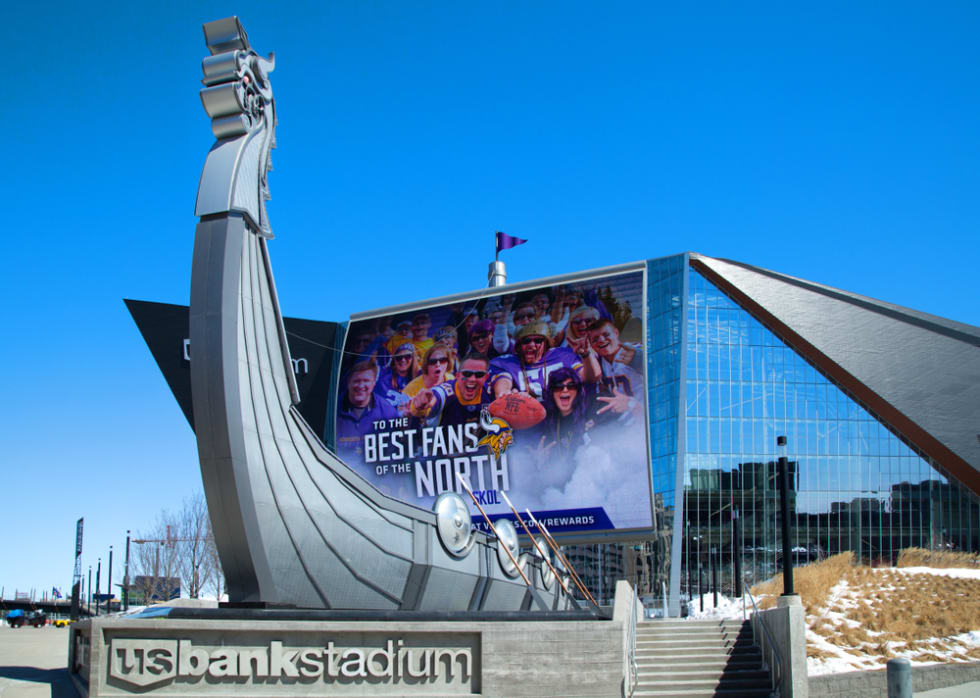
Minneapolis is a competitive sports city where baseball lovers are loyal to the Minnesota Twins, and football fans watch the Minnesota Vikings.
You can also watch the Minnesota Timberwolves play basketball, and Minnesota Wild play hockey. There's also a WNBA Team, the Minnesota Lynx, and the Minnesota United FC soccer team.
There's a reason the musician Prince stuck around Minneapolis his whole life. This city is filled with nightlife, live music, arts, and museums.
Live theater is also popular around Minneapolis, with Broadway shows at the Orpheum Theatre. The Orchestra Hall features classical music and moving performances from the Minnesota Orchestra.
Some of the top hospitals in the nation are located in Minneapolis. You can find healthcare or related industry jobs at Allina Abbott Northwestern Hospital and University of Minnesota Medical Center.
Beyond hospitals, healthcare is top-notch throughout the state. The Best & Worst States for Health Care Report also ranks Minnesota among the best in US healthcare.
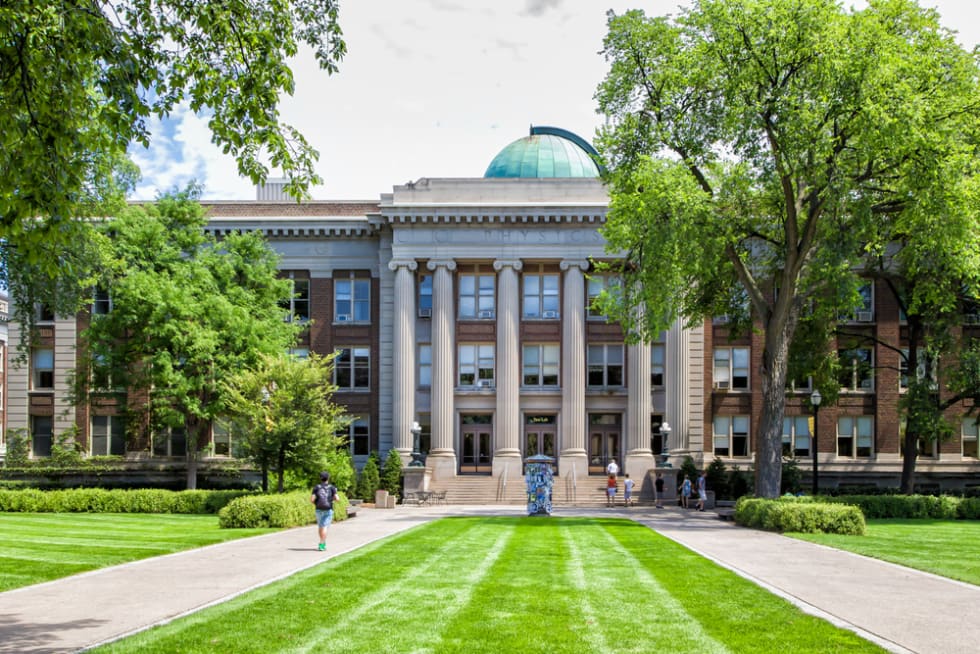
College students and professionals are in good company in Minneapolis. The city ranks as the fifth-most educated in the country. Nearly 35% of residents have a bachelor's degree or higher.
The city is home to the University of Minnesota Twin Cities, Augsburg University, and Minneapolis College of Art and Design. The world can also thank the University of Minnesota for inventing the Honeycrisp apple.
Creative spirits are welcome in Minneapolis. The city has incentivized low-cost housing for local artists to practice their craft. The city also has plenty of opportunities to showcase and sell artwork and creative pursuits.
The Minneapolis Institute of Art, Walker Art Center, Soap Factory, and more are central to the city's art scene. Sculptors are also featured around the city. A Minneapolis Sculpture Garden at the Walker Art Center features over 40 works of art to explore.
The Minnesota–Wisconsin football rivalry is alive and well in Minneapolis. The rivalry takes place between the Minnesota Golden Gophers and Wisconsin Badgers. It’s a big deal and locals turn out to show their loyalty and pride. You can join the crowd at TCF Bank Stadium in Minneapolis to watch the Golden Gophers play.
Ready to settle into Minneapolis and the Twin Cities area? Winters may be cold, but lakes, waterfalls, and biking are also within reach. Register for Apartment List or simply start browsing apartments in Minneapolis.
The weather in Minneapolis is characterized by frigid temperatures and tons of snow in the winter. Fortunately, Minnesota summers are warm and help to thaw everything that’s been frozen over the winter months.
Minneapolis’ time zone is Central Standard/Daylight Time (CST and/or CDT) depending on the time of year. It is also Greenwich Mean Time - 6 (GMT-6), which is one hour behind New York City and two hours behind San Francisco.
There’s a ton to do in Minneapolis. Start by heading out to a game for one of the city’s many sports teams, including the Minnesota Timberwolves, the Minnesota Lynx, the Minnesota Vikings, and the Minnesota Twins. After a game, head to one of Minneapolis’ nightclubs or theaters depending on the night’s vibe. Otherwise, Minneapolis boasts many restaurants, a waterfall, live music venues, and a wonderful park system that keeps residents busy.
Minneapolis is a city within Hennepin County, Minnesota. The high population of the city makes Hennepin County one of the largest counties in Minnesota.
Minneapolis offers residents the chance to enjoy a major city with a marvelously Midwestern vibe. The city’s distinct seasons, art scene, food industry, lively sports following, healthy economy, and more make it one of the most promising cities in the US.
The pros and cons of living in Minneapolis depend on the individual and their preferences. Generally, most Minneapolis residents enjoy the city’s picturesque winter landscape, sports teams, summer outdoor activities, growing job industry, nightlife, and entertainment options. On the flip side, some Minneapolis residents dislike the city’s lengthy winters, high taxes, and midwestern vibes.
The top seven Minneapolis neighborhoods include Downtown East, Ericsson, North Loop, Dinkytown, Longfellow, Northeast Minneapolis Arts District, and Prospect Park. Fortunately, there are many Minneapolis neighborhoods to choose from, so you’re not limited when it comes to finding a neighborhood that best suits you.
Living in Minneapolis is an interesting experience. With a population of 430,000 and substantial population growth in the past decade, Minneapolis is diverse and boasts a growing number of young professionals who want to make the Twin City their home.
Minneapolis levies an effective sales tax at a rate of 8.03% and levies an income tax at a rate that ranges from 5.35% to 9.85%.
Major employers in Minneapolis include Target and a growing number of tech companies. That said, there is a diverse job market in the city spanning industries like healthcare, manufacturing, government, retail, and hospitality.
There are many higher education institutions in Minneapolis, the most popular of which include Augsburg University, the University of Minnesota, and the University of Minnesota Twin Cities. There are many other universities and colleges in the city, which help account for the fact that Minneapolis is one of the most well-educated cities in the US.
First and foremost, if you are struggling to find something to do in Minneapolis, you can just head to the Mall of America. There are shops, restaurants, movie theaters, ice skating rinks, and more. Beyond that, you can enjoy some outdoor activities year-round, including ice fishing and swimming (hopefully at different times of the year!).


In unit laundry, Golf room, Patio / balcony, Granite counters, Hardwood floors, Dishwasher + more
In unit laundry, Wine room, Patio / balcony, Dishwasher, Pet friendly, 24hr maintenance + more